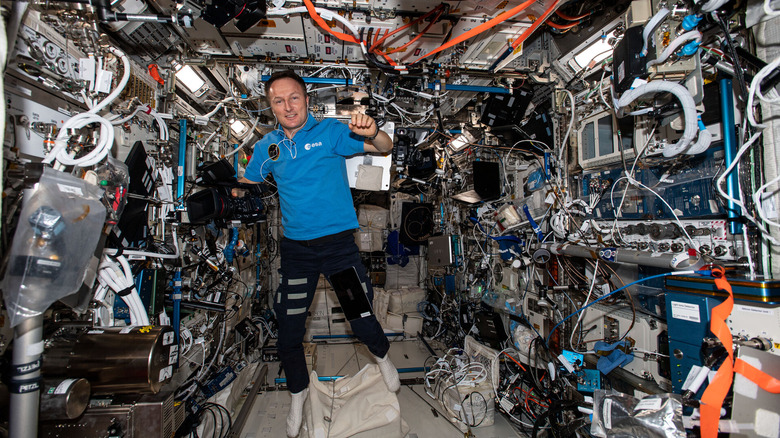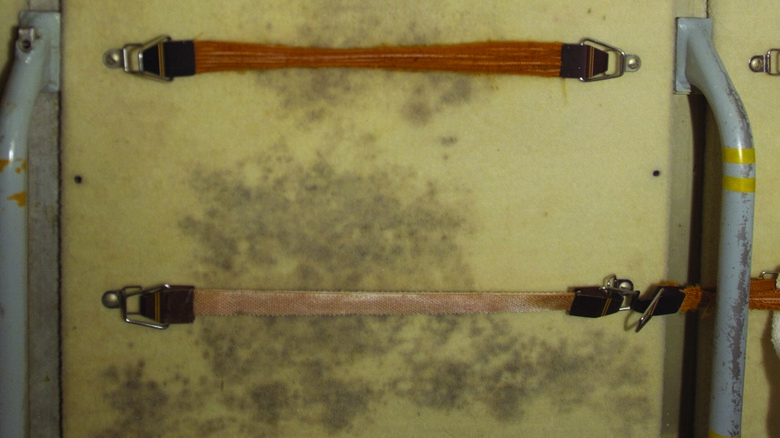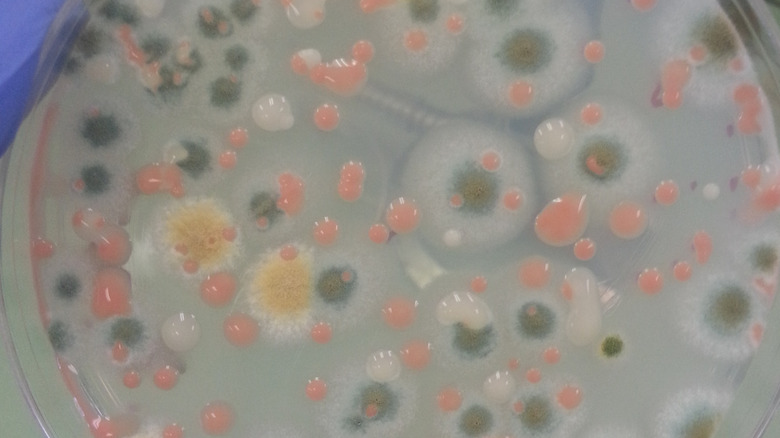How Researchers Are Fighting Microbes On The International Space Station
You might think that the back of your fridge is gross and hard to clean, but just imagine how much worse the problem could be if you were in space. The Russian space station Mir famously had bacteria and fungi found throughout it (via PubMed) and the International Space Station (ISS) is also known to host a wide variety of microbes (via PubMed). The good news is that you don't need to worry about space-born superbugs, as the microbes found in space are no more dangerous than those found on Earth, according to NASA. However, space agencies still want to find ways to keep the ISS clean from bacteria and fungi so that the astronauts there don't get sick.
"With astronauts' immune systems suppressed by microgravity, the microbial populations of future long-duration space missions will need to be controlled rigorously," said a European Space Agency (ESA) researcher, Malgorzata Holynska (via ESA). "So ESA's Materials' Physics and Chemistry Section is collaborating with Istituto Italiano di Tecnologia, IIT, to study antimicrobial materials that could be added to internal cabin surfaces."
The idea is to create a coating that can be applied to different parts of the space station to neutralize bacteria. Researchers are developing a coating that reacts with ultraviolet light to break down molecules of water in the air. The oxygen is broken down into highly reactive molecules called free oxygen radicals capable of neutralizing bacteria of all kinds. "Bacteria gets inactivated by the oxidative stress generated by these radicals," explained another of the researchers, Mirko Prato of IIT. "This is an advantage because all the microorganisms are affected without exception, so there is no chance that we increase bacterial resistance in the same way as some antibacterial materials."
Challenges of the space environment
Designing for space can take inspiration from Earth-based technologies, of course, but there are extra considerations to take into account when coming up with solutions to work on a space station. For example, antimicrobial technology needs to be safe for a confined environment where astronauts use a water recycling system.
"Antimicrobial coatings on Earth often make use of silver, but we want to do without it here," Malgorzata explained. "The issue is that in the confined environment of a spacecraft, prolonged exposure to silver could have negative health effects for astronauts — we don't want a heavy metal buildup in the onboard water, for instance." That's because being exposed to too much silver in a water supply can lead to health problems like skin and eye irritation, which wouldn't be good for astronauts.
Instead of silver, the researchers are trying out titanium oxide as an alternative. This compound has the advantage of being stable over time, so it shouldn't break down too quickly. But before it is used across the space station, the researchers need to check what happens when it degrades, because they want to make sure that any byproducts from oxidizing the bacteria aren't harmful. Another requirement is that the coating needs to be used on all sorts of materials, like glass and metal and fabrics. The layer needs to be thin enough that it doesn't interfere with material properties, such as by making fabric less flexible. To achieve this, the coatings being tested are extremely thin, at millionths of a millimeter in thickness.
Other ways to attack space bugs
In addition to the titanium oxide coating developed as part of a project called PATINA, the European Space Agency is also looking into other methods for keeping the space station clean. Some other ideas for cleanliness include developing coatings for materials that repel all water to ensure microbes don't have any moisture to help their development. There are also project ideas for using electro-static reactions to keep things clean or finding compounds that will kill off bacteria without harming the astronauts.
One important factor for researchers to understand when developing these technologies, though, is which bugs they are trying to protect against. That's why the ISS has experiments on board like a set of panels that astronauts are encouraged to touch regularly (via ESA). The five panels are made of different materials, and once they are returned to Earth, researchers will be able to see what kind of microorganisms have stuck to each of the panels and how long they survived. The researchers hope these developments won't only be useful in space, but may also help develop antibacterial technologies that could be used in healthcare facilities here on Earth.


